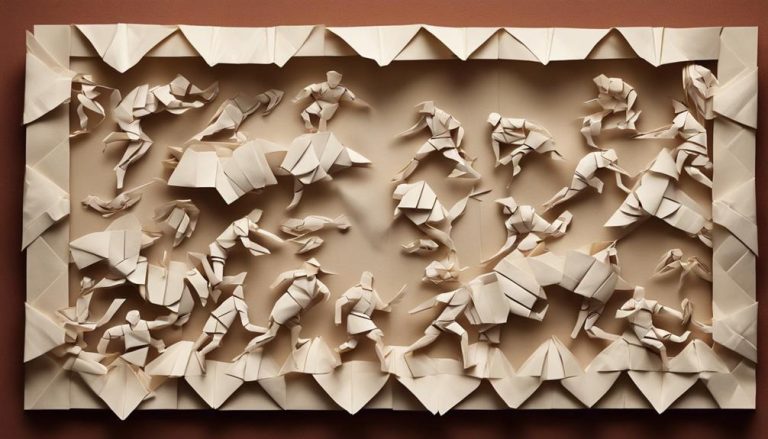General Rules of Supercross Racing
When it comes to navigating the intricate web of rules in supercross racing, think of it as meticulously following a complex map through uncharted territory. Understanding the nuances of race start procedures, flag signaling systems, and track boundary regulations is crucial to your success on the track. But what about the unspoken strategies of jumping and passing etiquette, or the non-negotiable safety gear requirements? As you gear up for the race, remember, every move you make could mean the difference between victory and defeat.
Race Start Procedures
Get ready to experience the adrenaline-pumping moment when the gate drops and the race begins in Supercross racing. At the starting line, tactics play a crucial role in determining your success. Before the race even begins, riders have their unique pre-race rituals that help them mentally prepare for the intense battle ahead. It's not just about the physical aspect; it's also about getting your mind in the right place.
Race start psychology is a key component in achieving a great start. Visualizing the perfect start, focusing on your breathing, and clearing your mind of any distractions are all part of the mental preparation needed. The moments leading up to the gate drop are filled with anticipation and nerves, but it's how you channel that energy that can make all the difference.
When the gate finally drops, it's a rush like no other. The sound of roaring engines, the smell of gasoline in the air, and the sight of dust flying behind you as you accelerate down the straightaway – it's a symphony of chaos that only the bravest dare to dance to. Remember, the start of the race sets the tone for the entire event, so make sure your starting line tactics and mental game are on point.
Flag Signaling System
As the gate drops and the race begins in Supercross racing, your awareness of the flag signaling system is crucial for navigating the track effectively and responding to race officials' directives. Understanding the signals and being able to interpret them swiftly can make a significant difference in your performance on the track. Here's what you need to know:
- Signal interpretation is key: Race control uses various flags to communicate important messages to riders. Knowing what each flag represents can help you anticipate track conditions and adjust your racing strategy accordingly.
- Flag communication is universal: Flags are a universal language in Supercross racing. They provide quick and clear messages that all riders can understand, promoting a safer and more organized racing environment.
- Rider awareness is essential: Being alert and responsive to flag signals is not just a rule; it's a skill that can give you a competitive edge. The ability to process flag information quickly can help you avoid penalties and stay ahead in the race.
- Stay focused, stay informed: Keep your focus sharp during the race to ensure you catch every flag signal. Missing a signal could lead to confusion or even penalties, so stay vigilant throughout the race.
Jumping and Passing Etiquette
Get ready to elevate your supercross game with crucial insights on jumping and passing etiquette. Master the art of jumping with technique tips that will have you soaring over obstacles effortlessly. Learn strategic passing maneuvers and the etiquette needed for clear communication on the track. Time to take your skills to the next level!
Jumping Technique Tips
Mastering the jumping technique in Supercross racing involves understanding and implementing proper jumping and passing etiquette to navigate the track efficiently and safely. When it comes to jumping, remember these key tips:
- Maintain Landing Control: Focus on landing smoothly to maintain speed and control.
- Attack Rhythm Sections: Approach rhythm sections with confidence, finding the right flow.
- Use Body Positioning: Lean back slightly when taking off to help with balance and control.
- Eyes Up, Stay Focused: Keep your eyes on the landing spot and stay focused on the track ahead.
Implementing these techniques will not only improve your performance but also ensure a thrilling and safe racing experience.
Passing Strategy Insights
To excel in Supercross racing, honing your passing strategy is crucial for navigating the track effectively and overtaking competitors with finesse. When it comes to passing techniques, timing is everything. Anticipate your opponent's moves, study their lines, and choose your moment wisely. Utilize inside lines to make a pass, but be respectful of other riders' space. Remember, Supercross is a fast-paced, high-intensity sport where split-second decisions can make or break your race. Develop a race strategy that includes when and where to make your moves. Stay aggressive but calculated, and always prioritize safety while pushing your limits. By mastering passing techniques and refining your race strategy, you'll increase your chances of reaching the podium.
Etiquette for Clear Communication
When navigating a Supercross track, clear communication through jumping and passing etiquette is essential for a smooth and safe race experience. To ensure a respectful and efficient environment on the track, keep these points in mind:
- Use Communication Signals: Signal your intentions clearly to other riders to avoid collisions and misunderstandings.
- Respect the Pit Lane: Be mindful of the pit lane and avoid unnecessary stops or delays that could disrupt the flow of the race.
- Maintain Consistent Speed: When approaching a jump or a turn, try to maintain a consistent speed to help others anticipate your movements.
- Be Courteous When Passing: When passing fellow riders, do so in a controlled and considerate manner to prevent accidents and promote fair racing.
Track Boundary Regulations
Navigating the track boundaries with precision is crucial in Supercross racing to maintain a competitive edge and avoid penalties. Keeping within the designated track boundaries not only ensures fair play but also contributes to the safety of both riders and spectators. Violating these boundaries can lead to time penalties or disqualification, hindering your chances of victory. To excel in Supercross racing, it's essential to understand and adhere to the track boundary regulations set in place.
—
| Track Boundary Regulations | Description |
|---|---|
| Stay within the track limits | Crossing over the track boundaries can result in penalties. |
| Respect the track boundaries | Deviating from the designated path can lead to disqualification. |
| Avoid cutting corners | Keeping to the track layout ensures fair competition. |
| Be mindful of safety zones | Certain areas are marked for safety; avoid these during the race. |
—
Safety Gear Requirements
You're gearing up for the thrill of Supercross racing, and safety is paramount. Let's zero in on the mandatory safety equipment, the must-have helmet and goggles, and the essential protective clothing requirements. These gear essentials are not just regulations – they are your shield against the intense challenges of the track.
Mandatory Safety Equipment
Ensuring your safety on the track requires adherence to strict guidelines regarding the mandatory safety equipment needed for Supercross racing. When gearing up for the race, remember these essential safety gear requirements:
- Helmet: Protect your head with a certified helmet.
- Boots: Invest in sturdy, high-top boots for ankle support.
- Gloves: Ensure a good grip and protect your hands from blisters.
- Body Armor: Safeguard your chest, back, and shoulders with quality body armor.
Helmet and Goggles
When gearing up for a Supercross race, the importance of a high-quality helmet and goggles cannot be overstated in ensuring your safety on the track. Proper helmet maintenance is crucial to guarantee it can effectively protect you in case of a fall or collision. Goggle fogging can lead to vision impairment, affecting your performance and safety. Invest in anti-fog goggles or use anti-fog sprays to prevent this issue. Your helmet is your shield, offering vital head protection during the intense race. Always ensure your helmet fits securely and meets safety standards. Remember, clear vision and a well-protected head are essential for a successful Supercross race.
| Helmet Maintenance | Goggle Fogging |
|---|---|
| Check for damage | Use anti-fog sprays |
| Secure fit | Invest in anti-fog goggles |
| Meet safety standards | Clean lenses regularly |
Protective Clothing Requirements
To guarantee your safety and performance on the track, proper protective clothing is essential for all Supercross racers. When it comes to gearing up for a Supercross race, your choice of protective clothing can make a significant difference in your overall performance and safety. Here are some key points to consider:
- Gear selection: Choose high-quality, durable gear that fits you well to provide maximum protection.
- Racing dynamics: Understand the racing dynamics of Supercross and select clothing that allows for ease of movement and flexibility.
- Protection: Invest in gear that offers protection for your chest, back, arms, and legs to minimize the risk of injuries.
- Comfort: Prioritize comfort along with protection to ensure you can focus on the race without distractions.
Penalties and Disqualifications
For competitors in Supercross racing, understanding the rules regarding penalties and disqualifications is crucial to maintaining fairness and safety on the track. When it comes to track behavior and race conduct, there are strict guidelines in place to ensure that all riders adhere to the highest standards of sportsmanship and safety.
Penalties in Supercross racing can range from minor infractions to severe violations, all of which are meant to uphold the integrity of the sport. Minor penalties may include warnings for aggressive riding or improper track behavior, while more serious offenses such as intentional contact or dangerous maneuvers can result in harsher consequences. These penalties aim to discourage reckless actions that could endanger not only the rider committing the offense but also others sharing the track.
Disqualifications are reserved for the most egregious violations of race conduct. Actions like intentionally causing a crash, ignoring safety flags, or engaging in unsportsmanlike conduct can lead to immediate disqualification from the race. Such measures are necessary to maintain a safe and respectful environment for all participants and spectators.
In the world of Supercross racing, penalties and disqualifications serve as vital tools for promoting fairness, safety, and good sportsmanship. By understanding and adhering to these rules, competitors contribute to a positive and thrilling racing experience for everyone involved.
Frequently Asked Questions
What Are the Most Common Types of Injuries That Occur in Supercross Racing?
In supercross racing, injuries like broken bones, concussions, and sprains are common. To prevent them, focus on proper gear, training, and technique. Such injuries can impact performance but with proper recovery, you can bounce back stronger.
How Do Supercross Riders Prepare Physically and Mentally Before a Race?
To prepare for a supercross race, mentally focus on visualizing success while physically conditioning your body through intense workouts. Engage in mental preparation techniques, like meditation or positive affirmations, to stay sharp and ready.
Are There Any Restrictions on the Type of Motorcycles That Can Be Used in Supercross Racing?
You'll be pleased to know that in supercross racing, there are specific regulations on the types of motorcycles that can be used. These rules ensure fair competition and safety standards are met.
How Do Supercross Racers Handle Extreme Weather Conditions During Races?
When facing extreme weather in supercross races, you adapt race day strategies. Your pit crew dynamics become crucial, ensuring quick bike modifications. Sponsorship deals may provide tech solutions. Stay focused, ride smart, conquer the elements.
What Kind of Training Regimen Do Supercross Riders Follow to Maintain Their Physical Fitness and Agility?
So you wanna know how supercross riders stay in top shape? Well, it's a mix of killer nutrition plans, hardcore strength training, grueling endurance workouts, and killer flexibility exercises. It's all about pushing limits and breaking barriers!






